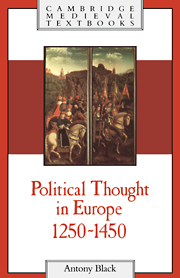4 - City-states and civic government
Published online by Cambridge University Press: 05 June 2012
Summary
We will now look at the structure of authority within political societies such as city-states, principalities, kingdoms and the church. To begin with, the civic governments of medieval Europe and of medieval/early Renaisssance Italy, from the twelfth to the fifteenth centuries, were a phenomenon unique in human history. Towns and cities developed as centres of local or long-distance trade, artisan manufacture and administration, which vitally affected their culture, social structure and political prospects. They were less self-sufficient than the city-states of ancient Greece, being dependent for food and raw materials on a countryside which they would have to struggle to control and whose inhabitants were seldom integrated, socially or politically, into the citizenry. In the more powerful kingdoms, such as France and England, they were corporate members of a much larger commonwealth with special trading privileges, fiscal responsibilities and certain powers of internal self-regulation. In the less defined, more contested parts of Europe – the Low Countries, northern and central Italy and the Rhineland corridor extending into south-western Germany – they entered into more equal relations with local lords. Some were real city-states ruling their hinterland: Milan, Venice, Florence, Genoa and, for certain periods and with less control over their countryside, cities of the Hanseatic League such as Lübeck and of the Netherlands such as Ghent. The eleventh to the fifteenth centuries were a golden age of small-scale government and civic independence.
- Type
- Chapter
- Information
- Political Thought in Europe, 1250–1450 , pp. 117 - 135Publisher: Cambridge University PressPrint publication year: 1992

